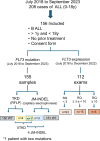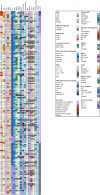Prevalence of FLT3 gene mutation and its expression in Brazilian pediatric B-ALL patients: clinical implications
- PMID: 39711880
- PMCID: PMC11658997
- DOI: 10.3389/fped.2024.1505060
Prevalence of FLT3 gene mutation and its expression in Brazilian pediatric B-ALL patients: clinical implications
Abstract
Introduction: There is consistent evidence that FLT3 may be a driver gene in B-ALL and that selected cases may benefit from the use of FLT3 inhibitors. Our study was conducted to evaluate the frequency and types of FLT3 mutations in pediatric patients with B-ALL, the relative expression of this gene, and their influence on clinical evolution.
Methods: We evaluated 156 children with B-ALL treated between July 2018 and September 2023. Screening for FLT3 mutations was performed using RFLP and fragment analysis, while FLT3 expression was assessed by qPCR.
Results: FLT3-TKD and/or FLT3-JM-INDEL mutations were found in 8 patients (5.1%). We did not identify any ITD-type mutations. None of the patients with identified FLT3 mutations presented recurrent rearrangements in B-ALL or alterations in the IKZF1, PAX5, or ERG genes, suggesting that FLT3 mutation may serve as the driving mechanism for leukemia in these cases. Two (2/8) patients with FLT3 mutations experienced disease relapse. Although we did not observe FLT3 overexpression among patients with FLT3 mutations, FLT3 expression levels were higher in these patients compared to WT patients. Four FLT3-WT patients presented FLT3 overexpression, defined as RQ > 10. FLT3 mutations or overexpression were not associated with relapses or survival rates.
Discussion: Our findings do not support the inclusion of FLT3 as a routine marker in the risk stratification of B-ALL patients; nevertheless, FLT3 alterations may be relevant for guiding personalized treatment approaches in specific clinical contexts.
Keywords: child health; molecular biology; precision medicine; precursor B-cell lymphoblastic leukemia-lymphoma; tumor biomarkers.
© 2024 Biojone, Guido, Cavalcante, Santos Junior, Pontes, Furtado, Córdoba, Magalhães, de Oliveira and Camargo.
Conflict of interest statement
The authors declare that the research was conducted in the absence of any commercial or financial relationships that could be construed as a potential conflict of interest.
Figures



 Two patients presented the p.Ile836del mutation, with one patient having this mutation exclusively and the other having it in conjunction with a FLT3-JM-INDEL (§).
Two patients presented the p.Ile836del mutation, with one patient having this mutation exclusively and the other having it in conjunction with a FLT3-JM-INDEL (§).




References
-
- Zhang L, Habeebu SSM, Li W. Chapter 10. Prognostic and predictive biomarkers in precursor B-cell acute lymphoblastic leukemia. In: Li W, editor. Leukemia. Brisbane, AU: Exon Publications; (2022). p. 165–93. - PubMed
LinkOut - more resources
Full Text Sources
Miscellaneous

